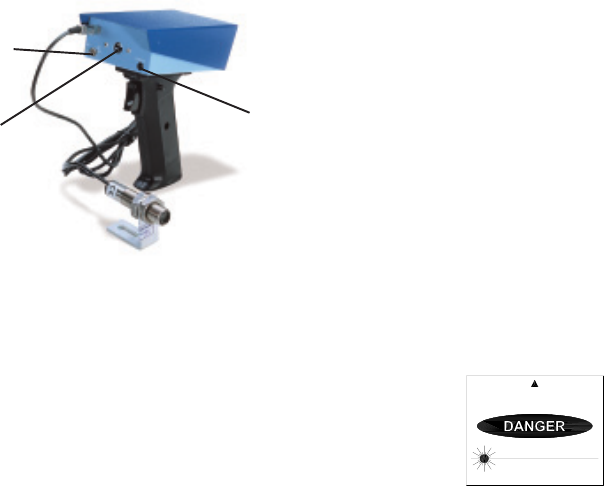
1
AVOIDEXPOSURE
LASERRADIATIONISEMITTED
FROMTHISAPERTURE
LASERRADIATION
AVOIDDIRECTEYEEXPOSURE
PEAKPOWER
WAVELENGTH
3mw
650nm
CLASSIIIALASERPRODUCT
SPECIFICATIONS
This product is designed for indoor or outdoor use under the following
conditions (per IEC1010-1):
Speed Range: 5 RPM to 100,000 RPM
Accuracy: ± 1 RPM or .01% of reading
Resolution: 1 RPM
Display: 6-digit 0.45” high liquid crystal
Display Update: Twice per second
On-Target Indication: Target (Bullseye) on lower left of display
Operating Distance: Range: Up to 10 feet [3.1 m] from leading edge
of reflective tape
Angle: Up to 45° from perpendicular to leading
edge of reflective tape
Power-On Switch: Pistol grip trigger - may be locked on with latching
push-button for longer duration measurements
Auto hold of last measurement for 90 seconds
Optical System: Visible laser light source
WARNING:
Do not view the laser beam directly as it
could be hazardous to the eyes. Do not
point the laser beam into another person’s
eyes. Do not view the laser beam with
telescopic devices.
Time Base: Crystal controlled
Power Source: 4 “AA” batteries; Recharger socket provided for
optional rechargeable batteries
Recharger Input: Max input 7.8 Vdc @ 50mA
Temperature: 41 °F [5 °C] to 104 °F [40 °C]
Humidity: Maximum relative humidity 80% for temperature
up to 88 °F [31 °C] decreasing linearly to 50%
relative humidity at 104 °F [40 °C]
4
Remote/Internal
Switch
Internal Optics
Lens
Recharger Jack
Figure 1 HHT21A-R
with Optional Remote Sensor (HHT20-ROS)
CALIBRATION AND SELF-TEST
The HHT21A SERIES is a crystal controlled digital instrument that requires
no calibration. However, the accuracy of the instrument can be checked at
any time by aiming it at an old style fluorescent light and observing 7200 ±2
RPM. In countries with 50 Hz. power line frequency, the display will read
6000 ±2 RPM.
NOTE: The Tachometer will not correctly read on energy-efficient
fluorescent lights.
BATTERIES
The HHT21A SERIES operates from four ‘AA’ size batteries which are
located under the hinged top of the instrument. To access these batteries,
grip the tapered cover at the optical lens end of the instrument and pull up.
The cover is hinged at the display end of the instrument and pivots fully out








